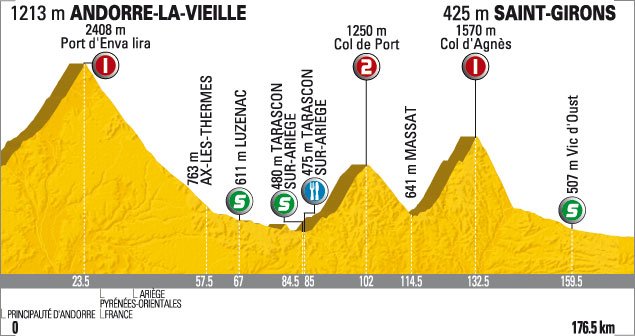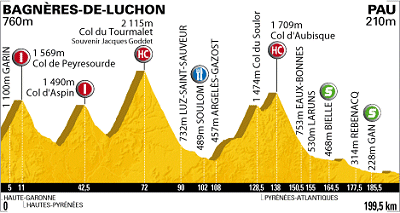No, it's still that. 25 for HC, 10 for cat.1, 5 for cat.2, 2 for cat.3 and 1 for cat.4, with HC, cat.1 or cat.2 points being doubled if it's a summit finish.
This means that in 2015, Froome winning a one-climb stage to a HC mountain more or less gave him the jersey by default as it was actually close to having more points for Pierre Saint-Martin than there were for every climb to that point in the race put together.
I despise the Tour's current system, it's basically that they didn't know how to recover the competition from the "Virenque method" and wanted to improve the prestige of it again. The existing system at that point was flawed specifically because the double points applied if it was the last climb of the day regardless of whether or not it was relevant, and for a period the Tour was putting out pathetic "high mountain stages" including several HC or cat.1 climbs but ending way away from the finish so that nobody but the breakaway would have any interest in contesting them, meaning that huge amounts of points could be collected in these stages that meant GC men weren't close enough to be tempted by the jersey, and what's more the lack of time bonuses and distances from climbs to the finish meant GC contenders weren't interested in fighting for the stage wins either, meaning the break was always given enough leeway that it was impossible for anybody but the escape to take those points. If you look at 2007 and 2008, there's nothing wrong with the GPM there - in 2007 Rasmussen held it, and it was eventually won by Soler, who was just outside the top 10 because though he was a great climber and won a big mountain stage, he struggled in flat stages and against the clock and lost out on GC as a result: the ideal rider to have honour the polka dots. In 2008, it was being bounced around the various Saunier Duval goats until they left the race after Riccò and Piepoli went positive, with the end result being that Bernhard Kohl, who had been diligently collecting leftover points, was perfectly placed to profit: a GC contender in the polka dots. It's only really been 2009 and 2010 where the mountains jersey became a farce in the Tour, and that was mainly as the stage designs were absolute dreck that meant it was only ever going to be a breakaway's plaything, but unfortunately for them because of the 2009 race being so controlled and tamely raced, only Pellizotti was sufficiently distanced early enough to take advantage of those garbage Pyrenean stages, and in 2010 because of the Spa stage being neutralized time gaps were smaller than anticipated coming into the Alps so few really strong climbers were sufficiently distanced to be tempted by the polka dots until it was too late and the Kings of the Breakaways had too big a lead in the classification.
Besides, I feel for Anthony Charteau, with it being generally put out there that it was him winning the jersey that made them realise they had to change the classification, that's quite insulting I feel. Besides, if there hadn't been a deal cut to allow Jérôme Pineau to collect points in the Madeleine stage so that a Frenchman had a leadership jersey on Bastille Day, it would have been very likely that Christophe Moreau would have won the jersey instead - he gave up a number of points that day that he had been sprinting successfully for earlier in the stage, and was the only one who could mathematically challenge Charteau on the Tourmalet stage, only for Radioshack to chase his break down to defend the lead in the Teams Classification. If Moreau wins it - a French former GC hope who was targeting it as a late career flourish, much as Stefano Garzelli had done in the Giro the year before and again a year later - does the change happen?
Part of the problem with the relative marginalization of the GPM, however, is simply that for a couple of reasons, there is little reason for a grimpeur to target it now - they will be targeting the GC. There are a few convergent factors that have given rise to this.
- Firstly, the increased control that teams are able to exert over the race and the generally improved levels of professionalism means most gregarii and domestiques are of a high enough standard to sufficiently protect the mountain goats in the rouleur stages. This, allied with the relative marginalization of the time triallist from GC contention, means that the deficits faced by the escaladores ahead of the mountains are smaller, which has the consequence of meaning that few are far enough down to take a flyer on the kind of long range move that was GC-minded but often used to see the GPM being decided as recently as the mid-2000s.
- The relative lack of time trial mileage in the attempts to manufacture close races and end the kind of damp squibs of the final week of the Indurain era with the mountains over and the ITT still to come has meant that the climbers are close enough that they only need a mountain or two to gain time back. If Chiapucci only needed 30 seconds over Indurain, Sestrières never happens and he goes a couple of km from the top using his better explosivity than the Banesto diesel, à la Purito.
- The rise of Unipuerto and the quest for ever steeper muritos as a stage design fad has meant that often the need for the climbers to go from afar and collect points over multiple cols in order to gain time are limited as well. These stages hold little interest for the King of the Breakaways type GPM rider, as there aren't as many points available for them as a multi-col stage, so you often see the KOM disappear out the back soft-pedalling, always a depressing sight. That was what the Tour was trying to prevent with the double-points situation, but now the difference is too great, so that the jersey can be won by accident.
- The fact that the Virenque Method was so successful has showed a whole generation of second-tier climbers and break artists that this is a good way for them to get the jersey and its prestige while not being GC relevant. As a result, you will see riders doing things like the softpedalling I mentioned above, focusing their efforts on intermediate stages and breakaways in mountain stages with the intention of accumulating points without any real intent or expectation of gaining a stage win out of it.
Fudging the points system as they have done is to my mind not ideal. I liked the old pre-2011 system, but they should have tweaked it a little. Made the cat.2 points more consistent (10-9-8-7-6-5-0?!), and only allowed double points for the final climb if it was within a fixed distance (say 30km for a HC, 20km for a cat.1 and 15km for a cat.2) from the finish, so that only the GC-relevant stages offered double points, but it didn't have to be an MTF for the points to be available. Plus: harder rouleur stages and more time trial mileage to make the climbers have to work harder. That's the way to increase the prestige of the GPM.














